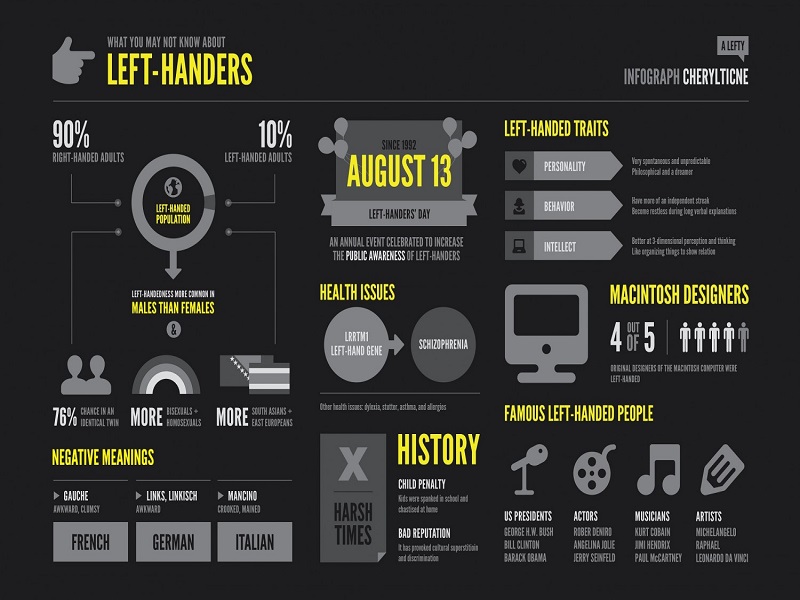via Science of People: In today’s “did you know?”, we’re exploring the science of handedness. Watch the video or read below to find out more:
Researchers believe that our handedness (tendency to be right or left-handed) is determined in the womb. The majority of humans are right-handed (a whopping 85-90%) and this makes sense– our right hand is controlled by the left hemisphere of the brain which is responsible for speech and writing. The right hemisphere of the brain controls the left hand and is associated with creativity and imagination. Does this mean left-handed people are more creative than right-handed? It’s possible. Let’s dive into the science of handedness a bit more:
The Science:
Scientists at the Universities of Oxford, St Andrews, Bristol and the Max Plank Institute in Nijmegen, the Netherlands have researched how handedness and our genetic code align. Their research revealed that a specific network of genes are likely associated with determining whether someone will be right- or left-handed. This determination happens in the womb before a baby is even born. Scientists have isolated the gene PCSK6, a gene “intimately involved in turning a spherical ball of equally oriented cells into an embryo that has discernible left and right sides.” According to an article in Time,
Researchers do offer caution that genes may only be one component of dexterity. The role of behavior and training may also contribute to which hand a child prefers, another example of the fascinating combination of nature and nurture.
The Brain:
Our brains are designed in an asymmetrical manner meaning that the right and left sides are responsible for different things. Just like you may be responsible for dishes and your partner is responsible for taking out the trash, the right hemisphere of the brain controls most emotional functions and the left hemisphere manages many thinking and intellectual skills.
We learned above that the use of the left hand is managed by the right side of the brain, the moods and emotional side. One study found that lefties may be more prone to depression and negative emotions since this side of their brain is activated more regularly.
Another study furthered this idea of our handedness and brain being interconnected. Researchers asked a group of right-handed participants to clench their right fist before memorizing a group of words. Remember, movement of the right hand signals the left side of the brain to ‘turn on’. These participants performed significantly better in recalling the memorized words than their counter-parts, a group of right-handers who clenched their left fists before memorization.
Dr. Daniel Geschwind, professor of psychiatry, neurology and human genetics at the University of California, Los Angeles says that while the majority of right-handers process language in the left-hemisphere, lefties have an equal distribution of this skill across their brains. This lack of asymmetry leads to more random and less specified skills. This wide distribution has a health benefit– if a left-handed person has a stroke on the left side of the brain (the language processing side), they tend to recover more quickly since their language processing skills are dispersed across the brain. There is a disadvantage, however. “Having more distributed language abilities probably makes the system more complicated, so it may increase the susceptibility to developmental [abnormalities] and neurodevelopmental disorders,” says Geschwind.
This begs a chicken or the egg type of question. Is the brain’s tendency toward asymmetry based on handedness or does the layout of the brain veer someone toward a preference? Geschwind believes this all may happen together: “Left-handedness is a marker for how the brain is organized in a more symmetric than less symmetric way.”
Caveman Hands:
Right-hand majority isn’t a trending topic. As humans, we’ve been using our right-hand as the dominant choice for over 500,000 years. And interestingly, this fact is determined by caveman teeth.
Dental records of our hunting and gathering ancestors were studied by researchers at the University of Kansas. They found that when our great, great, great- (and on and on) grandfathers processed animal hides, they would hold one side of the carcass in their hand and the other in their mouth. Scientists reviewed the wear and tear on fossilized caveman teeth to determine the dominant hand used.
According to researcher David Frayer, Ph.D, “All you need to have is a single tooth, and you can tell if our assumptions are right — if the individual is right- or left-handed.” They found that similarly to today, most of the records showed a dominant right hand.
And how about other species? Research has found that other mammals, including gorillas and chimpanzees exhibit the use of a dominant hand. David P. Carey, a neuropsychologist at Bangor University in the United Kingdom says that even dogs have a preferred paw. “Your dog is one-pawed,” said Carey. “If you force a dog to reach for a toy through an aperture, it will tend over many trials to use one paw over the other.”
Famous Lefties:
Lefties or ‘southpaws’ may be in the minority, but there are several famous ones you may have heard of. President Obama, anyone? Yep, he’s a leftie. Several past Presidents made the list as well:
- Bill Clinton
- George H.W. Bush
- Gerald Ford
- Harry S. Truman
- James A. Garfield
Some of your favorite musicians and actors may be the elusive leftie too. Here’s a few we found:
- Kurt Cobain
- Judy Garland
- Jimi Hendrix
- Paul McCartney
- Tim Allen
- Carol Burnett
- Robert DeNiro
- Nicole Kidman
And check out this awesome infographic on left-handers (click to expand):







